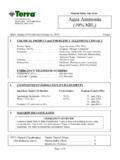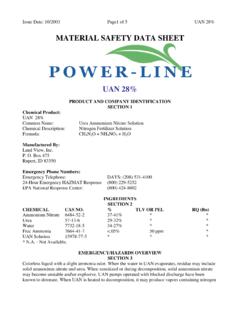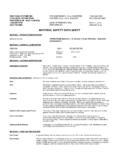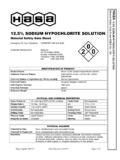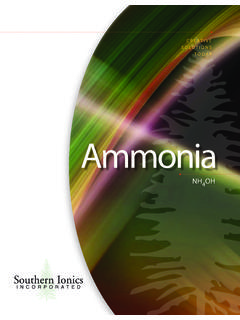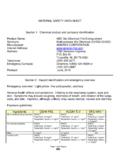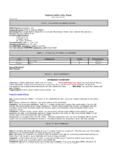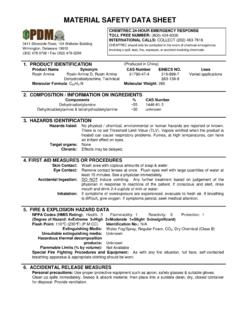Transcription of MATERIAL SAFETY DATA SHEET - Extinguishers
1 AFFF 3% FOAM CONCENTRATE (PN#04426) msds Page 1 of 13 MATERIAL SAFETY data SHEET Prepared to OSHA, CMA, ANSI, Canadian WHMIS Standards, Australian Worksfe and European EC Directive Standards PART I What is the MATERIAL and what do I need to know in an emergency? 1. PRODUCT IDENTIFICATION TRADE NAME (AS LABELED): AFFF 3% Foam Concentrate-PN#04426 MANUFACTURER'S NAME: AMEREX CORPORATION ADDRESS: BOX 81 Trussville, AL 35173-0081 EMERGENCY PHONE: 1-800-424-9300 (CHEMTREC) BUSINESS PHONE.
2 (205) 655-3271 NUMBER: 3082 DANGEROUS GOODS CLASS/SUBSIDIARY RISK: Class 9 (Miscellaneous Hazardous Substance) HAZCHEM CODE (AUSTRALIA): 2X POISONS SCHEDULE NUMBER (AUSTRALIA): Schedule 6 DATE OF PREPARATION: June 15, 1995 DATE OF REVISION: August 13, 2002 2.
3 COMPOSITION and INFORMATION ON INGREDIENTS CHEMICAL NAME CAS # EXPOSURE LIMITS IN AIR ACGIH-TLV OSHA-PEL NIOSH OTHER TWA STEL TWA STEL IDLH EINECS # % w/w mg/m3 mg/m3 mg/m3 mg/m3 mg/m3 mg/m3 Perfuloroalkyl Sulfonate Salts Proprietary NE NE NE NE NE NE Amphoteric Fluoroalkylamide Derivative Alkyl Sulfate Salts Mixture Proprietary 1-5 NE NE NE NE NE NE Triethanolamine 102-71-6 203-049-8 5 NE NE NE NE DFG MAK: Danger of Sensitization of the Skin Carcinogen: IARC-3 Diethylene Glycol Monobutyl Ether 112-34-5 203-961-6 19-21 NE NE NE NE NE DFG MAKs.
4 TWA = 100 PEAK = 1 MAK, 15 min., average value DFG MAK Pregnancy Risk Classification: C Water 7732-18-5 Unlisted 69-71 NE NE NE NE NE NE Other components. Each of the other components are present in less than 1 percent concentration ( concentration for potential carcinogens, reproductive toxins, respiratory tract sensitizers, and mutagens).
5 Balance None of the other constituents in this mixture contribute significantly to the hazards associated with this component. All pertinent hazard information has been provided in this MATERIAL SAFETY data SHEET , per the requirements of the Federal Occupational SAFETY and Health Administration Standard (29 CFR ), State equivalent Standards, Canadian Workplace Hazardous Materials Identification System Standards (CPR 4) and European Community Standards (Commission Directive 93/112/EEC), and applicable Australian regulations [NOHSC: 1005(1994)]. NE = Not Established. See Section 16 for Definitions of Terms Used.
6 NOTE (1): ALL WHMIS required information is included in appropriate sections based on the ANSI format. This product has been classified in accordance with the hazard criteria of the CPR and the msds contains all the information required by the CPR, EC Directives and WorkPlace Australia. AFFF 3% FOAM CONCENTRATE (PN#04426) msds Page 2 of 13 3. HAZARD IDENTIFICATION EMERGENCY OVERVIEW: This is a clear amber, slightly basic solution with a faint odor characteristic of amines ( ammonia -or fish-like). Health Hazards: This product may mildly to moderately contaminated tissue by inhalation skin or eye contact, depending on concentration and duration of exposure.
7 May cause sensitization to the skin and allergic reaction in susceptible individuals, due to the presence of Triethanolamine. Inhalation of high concentrations may result in adverse effects on central nervous system. May be harmful or fatal if swallowed. Flammability Hazard: This product is not flammable. In the event of a fire, the components of this product may decompose to release smoke, irritating vapors and toxic gases ( , carbon dioxide, carbon monoxide, oxides of nitrogen, oxides of sulfur, and hydrogen fluoride). Reactivity Hazard: This product is not reactive. Environmental Hazard: Release of large quantities of this product to an aquatic or terrestrial environment may cause harm to plants and animals.
8 Emergency Response Considerations: Emergency responders must wear personal protective equipment appropriate for the situation to which they are responding. SYMPTOMS OF OVER-EXPOSURE BY ROUTE OF EXPOSURE: The most significant routes of occupational overexposure are inhalation of vapors and contact with skin and eyes. The symptoms of overexposure to this product, via route of exposure, are as follows: INHALATION: Inhalation of this product can cause mild to moderate irritation of the respiratory system, throat and nose, depending on duration and concentration of exposure. Symptoms may include coughing, sore throat and nasal passages, and sneezing.
9 Inhalation of high concentration may result in depression of the central nervous system. Symptoms may include drowsiness, dizziness, confusion, incoordination, slurred speech, slowed reaction time and unconsciousness. CONTACT WITH SKIN or EYES: Skin contact may cause mild to moderate irritation of skin tissues, depending on concentration and duration of exposure. Prolonged skin exposure may result in defatting of the skin and the development of dermatitis, with symptoms of dry, red, itchy skin. The Triethanolamine component of this product is a known skin sensitizer in humans and may cause allergic skin reaction in susceptible individuals.
10 Symptoms can include rash, itching, swelling, blistering or welts. Once sensitized, exposure to a very small amount can cause allergic reaction. Contact with vapors of this product may cause moderate irritation. Direct contact with the liquid will cause immediate irritation, with tearing, pain, redness and swelling. Low concentration vapor contact with the eyes can lead to a visual disturbance known as halo vision or blue haze . Symptoms include blurred or foggy vision, with objects appearing bluish, halos around lights and sensitivity to light. This condition may be delayed after exposure by several hours, but will normally end within several days.
